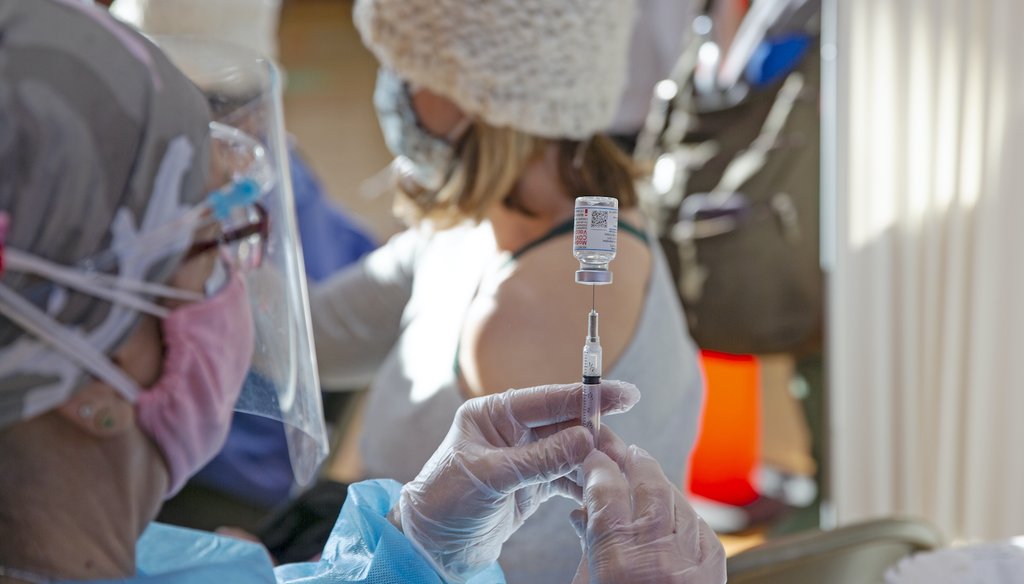Stand up for the facts!
Our only agenda is to publish the truth so you can be an informed participant in democracy.
We need your help.
I would like to contribute

A woman prepares a dose of the Moderna COVID-19 vaccine. (AP Images)
If Your Time is short
-
The vaccine rollout has been behind schedule so far, but it’s still possible for life to return to something close to normal by the fall.
-
For that to happen, vaccination rates will need to ramp up, vaccine supply will need to meet demand, and hesitancy to get vaccinated will need to decrease.
When Moderna and Pfizer announced in November that they had both developed vaccines more than 90% effective against COVID-19 infection, some public health experts expressed optimism that life in the U.S. could return to normal by spring.
At the time, Moncef Slaoui, chief scientific adviser of the U.S. vaccine development and distribution program Operation Warp Speed, predicted that enough Americans could be vaccinated by May 2021 to allow a return to a relative normal. That would entail continued masking and some restrictions at public gatherings, but it would also mean that some of the most stringent regulations could be relaxed.
After two months and a chaotic vaccine rollout, the chances of reaching that goal have dimmed. By January, only 3 million Americans had been vaccinated, 17 million people short of the target set by the Health and Human Services Department for the end of 2020.
Given the delays, is it still realistic to hope for normalcy by spring?
The sad answer, according to public health experts, is no. The spring estimate was always optimistic, and the federal and state governments are still grappling with various challenges that complicated the start of vaccine distribution.
The experts we spoke with were generally hesitant to make predictions, but most said that we might see a return to more normal life in the fall, with some safety precautions enduring past then. And for that to happen, several things will have to fall in line: The kinks in distribution will need to be ironed out, other vaccine candidates will have to be greenlighted, and public acceptance of the vaccine will have to increase.
In September, the Trump administration announced its plan to allocate the vaccine supply among states and U.S. territories: The federal government, through Operation Warp Speed, would purchase tens of millions of doses from the manufacturers, and pass them along to state authorities, who would handle distribution to providers like hospitals and pharmacies.
The U.S. has never attempted to distribute a new vaccine to so many people in such a short time, and many public health experts had predicted that the size and scope of the rollout would inevitably cause some problems. In addition, the unique characteristics of the COVID-19 vaccines pose additional challenges for distribution. The Pfizer vaccine must be stored at ultracold temperatures, and both vaccines are most effective when administered in two shots several weeks apart.
But experts also told us that some of the issues could have been avoided with better communication and planning from the federal government. Many states have complained that they weren’t informed about how much vaccine they were slated to receive and when — making logistical planning difficult, said Howard Forman, a physician and public health expert at Yale University.
What’s needed now is "an overarching federal strategy to guide local level, detailed planning around each type of vaccination provider and location, how many vaccines the location can administer per day, who is going to go where," said Tom Friedan, former director of the Centers for Disease Control and Prevention. "Effective communication and engagement with people and federal money to support this effort."
Finally, many state and local health departments have lacked the funding and resources to execute a successful mass vaccination campaign. According to Kelly Moore, deputy director of the Immunization Action Coalition, states had around $340 million available to implement vaccine programs by the end of December, even though billions were needed to train personnel, secure necessary supplies, and support educational outreach activities to vulnerable and high-priority communities.
Congress approved $8 billion at the end of 2020 to fund vaccine distribution as a part of the COVID-19 relief package. However, Moore said, it will take many more weeks for those dollars to have a major impact on the vaccination process.
Public health experts we spoke with said that there are good reasons to believe that vaccination rates will increase as states learn from their initial mistakes and establish reliable distribution networks.
"As we operationalize the program it’s going to speed up," said Dr. LitJen Tan, chief strategy officer for the Immunization Action Coalition. "We vaccinate about 150 million people against the flu every year in two and a half months, so the capacity to vaccinate a lot of people is there. Flu vaccines aren’t like the COVID-19 vaccines, so we won’t reach that number, but we can get pretty darn close."
If Americans are to return to a semblance of normal life in the fall, enough vaccine will have to be produced to meet demand, said Jennifer Kates, senior vice president at the Henry J. Kaiser Family Foundation. Pfizer and Moderna plan to produce a combined 200 million doses of vaccine within the first three months of 2021, enough to vaccinate 100 million people. But on Jan. 12, the Trump administration relaxed its guidelines, making the rest of its vaccine supply immediately available and instructing states to allow all residents over 65 access to the vaccine. According to Kates, this would widen the pool of eligible recipients to 180 million. The looming supply problem could ease if other vaccine candidates are greenlighted soon.
One unanswered question is how long the vaccines confer immunity. If protection turns out to be temporary, the challenge of getting booster shots to already-vaccinated groups could further complicate problems with vaccine manufacturing and distribution.
Another is whether the public will embrace the vaccine to the extent needed to confer broad immunity. The COVID-19 vaccines, developed in a matter of months, have been subjected to close scrutiny by medical experts. However, some studies suggest that people are more hesitant to take them than normal vaccines that have been around longer. As of early January, only 53% of healthcare workers had elected to take the vaccine when it was offered to them.
Tan said that educational campaigns to promote faith in the vaccine are currently being launched.
"These won’t be magic bullet campaigns," he said. "But some of them seem to be working, and more healthcare workers are saying they’ll get the vaccine."
Our Sources
Interview with Dr. Litjen Tan, Chief Strategy Officer for the Immunization Action Coalition, Jan. 14, 2021
Interview with Jennifer Kates, senior vice president at the Henry J. Kaiser Family Foundation, Jan. 15, 2021
Email interview with Kelly Moore, deputy director of the Immunization Action Coalition, Jan. 15, 2021
Email interview with Tom Friedan, former Director of the Centers for Disease Control and Prevention, Jan. 15, 2021
Email interview with Howard Forman, a physician and public health expert at Yale University, Jan. 15, 2021
Christopher Hooks, Tweet, Dec. 31, 2020
CNN, Azar has met with Biden's transition team and says 20 million Americans could be vaccinated in 'the next several weeks,’ Dec. 10, 2020
The Guardian, US vaccine expert predicts life could be back to normal around May, Nov. 22, 2020
Independent, Elderly forced to sleep in lawn chairs to queue for vaccines in Florida amid chaotic first-come-first-served rollout, Dec. 30, 2020
Los Angeles Times, Chaotic COVID-19 vaccine rollout leads to more deaths, experts say, Jan. 14, 2021
New York Times, Johnson & Johnson expects vaccine results soon but lags in production, Jan. 13, 2021
PolitiFact, What are state and federal plans for distributing COVID-19 vaccine? Dec. 9, 2020
PolitiFact, What we know about the new COVID-19 vaccine rollout strategy, Jan. 13, 2021
Kaiser Family Foundation, Distributing a COVID-19 Vaccine Across the U.S. - A Look at Key Issues, Oct. 20, 2020
StatNews, Frustration over vaccine rollout builds, as new variant reported in U.S. for first time, Dec. 29, 2020
Tax Foundation, The COVID-19 Relief Bill contains over $100 billion in state aid after all, Dec. 23, 2020
U.S. Department of Health and Human Services, Trump administration releases COVID-19 vaccine distribution strategy, Sep. 16, 2020
Vox, It’s essential to understand why some health care workers are putting off vaccination, Jan. 11, 2021
Washington Post, Biden team sees risks in Trump decision to widen vaccine pool, Jan. 12, 2021


























